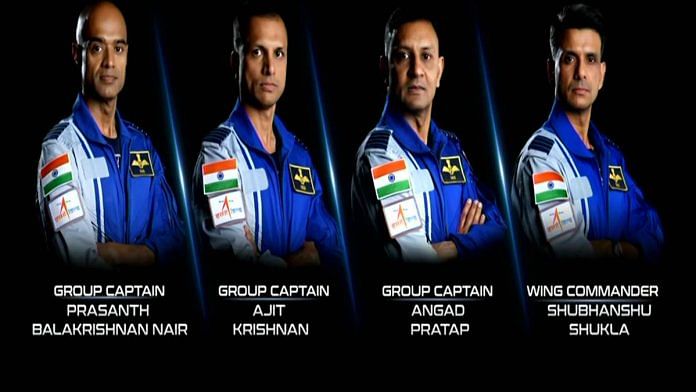Bengaluru: The four candidates selected for India’s maiden human spaceflight mission Gaganyaan — P. Balakrishnan Nair, Angad Prathap, Ajit Krishnan and Shubhanshu Shukla — are all from the Indian Air Force and have extensive flying experience, which is a key requirement for the spaceflight.
Prime Minister Narendra Modi announced their names at the Vikram Sarabhai Space Centre (VSSC) in Kerala’s Thiruvananthapuram Tuesday.
The candidates, along with others, went through a rigorous screening, selection, and training process starting 2018-2019 in two countries (India and Russia) and a dozen different environments, before being confirmed as India’s historic astronaut candidates.
Three of the four candidates will eventually take part in the three to seven-day mission, projected to be launched by 2025, and will be the first Indians to launch to space from Indian soil. They will also become the only Indian citizens to fly to space after veteran pilot Rakesh Sharma.
While the Indian Space Research Organisation (ISRO) has not made public the specifications for how the astronaut candidates were selected, the selection and training process across the world tends to be similar.
Astronauts are experienced professionals in their fields, such as medicine, geology, and even flying. Thus, candidates are typically experienced and older. For Gaganyaan, the minimum age to apply for astronaut selection was 39.
There is also the requirement of a basic degree in science or engineering, followed by professional experience. For NASA, anyone with about 1,000 hours of flying in a jet aircraft also qualifies.
Additionally, there are interviews, after which candidates are required to submit to medical and physical fitness tests relating to eyesight, blood pressure and cardiovascular health. Their height must also fall within an allowed range (to be able to comfortably operate and be accommodated in the space capsule, and be able to reach all systems at all times).
The shortlisted candidates then move on to preliminary training which involves being exposed to an environment that simulates the microgravity of spaceflight. This is achieved by using a jet aircraft that performs manoeuvres to produce brief weightlessness. They also perform military water survival tasks, train for spacewalk and undergo swimming tests while wearing a mock spacesuit.
The candidates further train to deal with emergencies, learn robotic skills and familiarise themselves with any languages they might be exposed to during emergency spaceflight (US candidates are expected to learn Russian and vice-versa, as both occupy the International Space Station (ISS) together).
The entire training process might take 18 months to two years, after which final selection for mission-specific training takes place. India had shortlisted 12 and then 10 candidates, and ultimately announced the final four.
The first batch of candidates are all men as they could amass flying hours from the Indian Air Force, which inducted its first women jet or fighter pilots only in 2016.
Also Read: India completes key test in Gaganyaan space mission, hours after halting planned lift-off
Becoming flight-ready
The four candidates were selected after a final round of training in Russia by the launch service provider Glavkosmos. They underwent further training there for 11 months as ISRO has entered a deal with the Russian space agency ROSCOSMOS to have astronaut candidate preliminary training.
The Russian agency is a veteran in human spaceflight since Soviet times, and has facilities conducive to the training process that India has not yet built. It also launched astronaut Rakesh Sharma into space on a Soviet rocket in 1984.
The candidates completed their training in Russia at the Yuri Gagarin Cosmonaut Training Center, familiar to Sharma.
They are currently undergoing flight training in Bengaluru, which involves spacecraft-specific engineering and controls understanding. This will involve classroom training, physical fitness training, simulator work, and flight suit training.
The candidates are also all obtaining an M.Tech degree at Bengaluru’s Indian Institute for Science, whose faculty had worked with them on ground training.
According to the ISRO, they will also cover academic courses, aero-medical training, parabolic flight microgravity exercises, recovery and survival training, flight systems training, and “mastering” of flight procedures on simulators.
Training footage released by ISRO reveals aspects of survival training, parabolic weightlessness, extreme g-force simulation, psychological tests, and more. It also showcases the strict physical training programme the candidates are under.
Trip to ISS
After completing the final modules of their training, three of the pilots will be selected to fly on the Gaganyaan mission.
Onboard, they are expected to perform some experiments that will be announced before the flight. These will be microgravity experiments placed inside and outside the crew module. They will fly 400 km above the Earth, and return three to seven days later by splashing into the Indian Ocean.
Apart from the Gaganyaan mission, ISRO and the US National Aeronautics and Space Administration (NASA) plan to collaborate on an ISS mission, and India is expected to send two candidates to train at NASA for a future trip to the space station.
One candidate will be selected from the two to fly this year on a week-long trip to the ISS, becoming the first Indian citizen to visit the space station. Astronauts Kalpana Chawla and Sunita Williams, both of Indian heritage, had become US citizens before their spaceflight.
Training for the ISS mission, expected to begin this year, will consist of additional modules specific to the space station, and also to daily life within the space station with multinational astronauts. At the ISS, those inside undergo daily physical training for health and also perform experiments.
According to ISRO chief S. Somanath, the two Indian astronaut candidates for the ISS will be selected from a shortlist of four. It is unclear if they will be from the current batch of pilots who are undergoing Gaganyaan-specific training.
(Edited by Nida Fatima Siddiqui)
Also Read: Crucial test for ISRO’s Gaganyaan tomorrow — how crew will escape if mission is aborted



